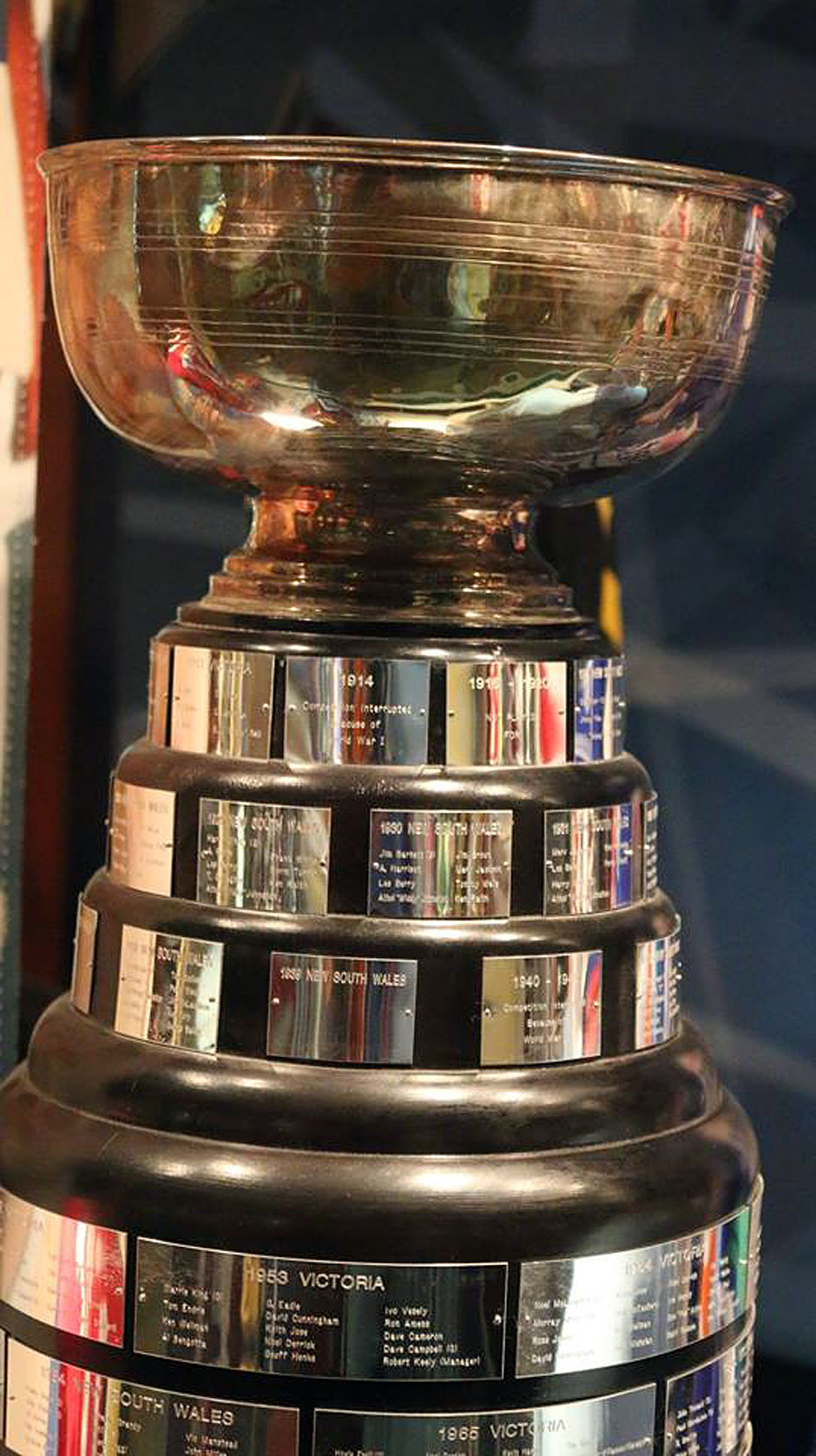Legends
home
A Cool Tradition. A Dream of Champions. Legends of Australian Ice.
Organised ice hockey has been played in Australia for over a CENTURY.
In fact, the ice hockey tradition here is so richly steeped in EMINENCE,
The booming years of MARVELLOUS MELBOURNE,
And the earliest EMERGENCE of the sport internationally,
One wonders how on earth its STORY
Was ever able to be LOST for one whole century,
Like DUST between the cracks of history.

During the second world war Melbourne's twin rinks at today's Southbank and the Upper Esplanade in St Kilda were incubators for a new generation of junior ice hockey players. They went on to launch Australian ice hockey onto the world stage at the 1960 Olympics in California. This article is a tribute to their pioneering achievement in Australian hockey's quest for world competitiveness, and those who dare to follow in their footsteps. — Image: VIHA MVP Trophy. Photo by Jason Sangwin.
[ HOCKEY ] Hockey as a Second F*cking Language
Champions Are Made, Not Born
![]() At its best professional sport is the peak of the sports industry that supports those organisations below it by generating financial resources and cultural cachet. At its worst, it is a rapacious commercial animal with an insatiable appetite for financial, cultural and social resources.
At its best professional sport is the peak of the sports industry that supports those organisations below it by generating financial resources and cultural cachet. At its worst, it is a rapacious commercial animal with an insatiable appetite for financial, cultural and social resources.
— Sport Management: Principles and Applications by Hoye, Smith, Nicholson, Stewart, Routledge, 2015. [1]
![]() We must always take heed that we buy no more from strangers than we sell them, for so should we impoverish ourselves and enrich them.
We must always take heed that we buy no more from strangers than we sell them, for so should we impoverish ourselves and enrich them.
— Sir Thomas Smith, English scholar and diplomat, 1549. [4]
![]() Perhaps the most powerful lesson other brands can learn from Nike is the need to act in accordance with the reality of the world we live in. In a mutually dependant, intimately connected global community facing several major crises, brands need to operate with an expanded definition of self-interest that includes the greater good.
Perhaps the most powerful lesson other brands can learn from Nike is the need to act in accordance with the reality of the world we live in. In a mutually dependant, intimately connected global community facing several major crises, brands need to operate with an expanded definition of self-interest that includes the greater good.
— Simon Mainwaring, branding consultant, advertising creative director, and social media specialist and blogger. [5]
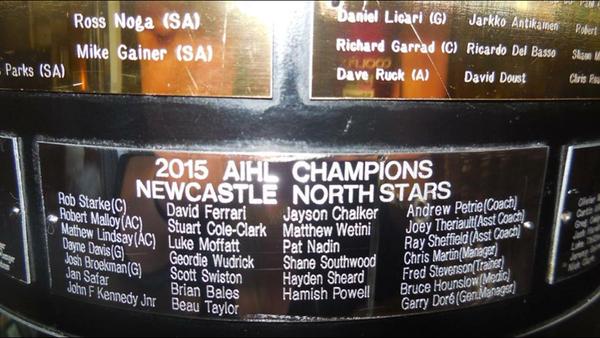
ONCE UPON A TIME THERE WAS A BOY who loved a sport, and its mastery was a question he wanted to spend his whole life answering. Whatever the soul of hockey is made of, it and his were the same. The people he met were never surprised to learn that he was born in the driest continent, not the subarctic winter of central Quebec or Sweden, nor even Nuuk in Greenland where there are twenty-three words for snow. He learned to skate at the age of ten, not five, lost for his State that same year, and his country when he was seventeen, but this particular season he was losing for a team that was in a league of its own, a lower league of its own, the off-season having left it a train-wreck, a smoking ruin, an empty carcass picked over by unsporting desperadoes. The secret, he told himself, is learning how to lose. If you can pick-up after a crushing defeat, week after week, and win just one game, you are going to be a champion someday, even if they take your players, take your coach, take away your only points. Which was just as well since the only things they did not take were all his team's losses and his soul because whatever it was made of, it and hockey were the same.
Who among us can appreciate the disadvantage that Australian-born ice hockey players experience internationally? Why, who among us even cares? But I will tell you anyway because hockey is a second f*cking language, and disadvantage here is due not only to the tyranny of distance, the remoteness of the sport's centres of excellence in Europe and North America or, for that matter, in the nearest pro league half that distance north of here in East Asia. It is also because we are too f*cking nice.
Since time immemorial, any overseas player who rolled up to an Australian ice hockey comp was given a spot, while most overseas leagues have been heavily protected, and still are. The few exceptions are usually the independent leagues outside the controlling authorities, such as the GMHL, a Junior A league based in Ontario, a pay-to-play league operating outside Hockey Canada. There are up to a dozen young Australians there this summer, paying for development or practice they cannot get at home or, at the very least least, buying overseas experience for their CV.
Take the Canadian Hockey League (CHL), the top-notch quality junior competition that is considered professional by some authorities, including the NCAA, because its players earn a small stipend. Its three leagues and sixty teams represent nine Canadian provinces (fifty-two teams) as well as four American states (eight teams), and it has a limit of two import players. In the amateur Canadian Junior Hockey League (CJHL) — a Canadian junior A association — teams are allowed a maximum of eight imports, but they never lose their import status. Unlike the AIHL, a club can't naturalize its imports, freeing-up a spot to recruit another one and so import a whole team of overseas-born players.
In the 2015-16 season of Australian football's A-League, a quota of five imports per club was reduced to four. It is expected that this will soon become three imports from anywhere in the world, and one from Asia. The football development community consider this is a good thing because it will allow more spots for up and coming Australian players. But invariably there are clubs such as the Brisbane Roar who prefer to import ready-made players from overseas, typically because it instantly improves their bottom line. Clubs have to work harder and smarter to develop locals through their academies and programs, and that can take years if it has been neglected, as was the case with most AIHL clubs until a few years back. After all, why wait when you can have the instant injection of imported sporting nous for a bargain price — there is no shortage of supply, plenty of competition, and even more price-cutting.
Yet, the reduction of football imports is in the national interest because it will help the rebuilding of the Socceroos by making more Australians available. This is widely acknowledged throughout the sport and, although the most self-serving clubs never mention it, it will also create more pressure to fill every A-League slot with a top quality player. That is good for the spectacle, good for fans, good for all the same things that the most self-interested clubs like to attribute to imported “stars”. All of which leaves one wondering why a reduction in our dependence on the players of another nation is not similarly respected by the controlling authorities of Australian ice hockey. Or is it? But, wait, there is more.
The A-League's anticipated quota of one Asian import strengthens links to markets in neighbouring Asia, where the world's "economic centre of gravity" continues to move. Australian football has been drifting with it for some years now, moving away from its centres of excellence in Europe, as if drawn by some irresistible force, a magnetic attraction. Which is what it is, of sorts, for what could be more magnetic than the potential income from a kaleidoscopic explosion of new sponsors seeking television exposure in Asia's emerging new and rapidly growing broadcast markets?
Then there are still other sports that have done similarly, such as Australian basketball which is also pointed to Asia, away from North America. Most NBL teams have historically featured only one or two American imports, except for the period when it was flooded by imports and collapsed, and from which it is still rebuilding in a completely different way. Teams are once again limited to having two non-Australasians on the roster at any one time and a new marquee system helps to get the very best value from that by permitting one player a salary paid outside the cap, room enough to attract a real gun import. After years absence from Australian TV, all NBL games are now broadcast in prime time on Foxtel, cashing-in on the rising demand for broadcasting rights with Australian stars.
Yet, Australian sports are not always winners in the rise of the Asian markets. Some, such as tennis, are instead now losing big sponsors to the athletes of promising Asian leagues that are relatively unknown here. Australian ice hockey faces the problem of having underdeveloped players compared to most other participating countries, and that could easily leave it dependent on others for elite players, if it is not already. The sport is very expensive by any measure, but on top of that our players pay a premium for imported hockey equipment that is not available here, such as hockey sticks and protective wear. Add Australia’s geographic isolation to the mix, the cost of regularly playing on the other side of the globe for training and tournaments, and you have a very fine recipe for making local elite ice hockey players particularly vulnerable. They are seriously disadvantaged with a cherry on top. This is why the New Zealand Ice Hockey League permit their teams to dress four import players per game like Australia and only two assimilated (naturalized) players who either intend to play for New Zealand or live there long-term.
Sweep aside the laissez-faire ideology and we see that markets are different around the world. The global market might be a free market in theory, but in practice it is not a level playing field at all. Its problems include short-term profit orientation, a tendency to produce a disparity of wealth, and its drive to neglect the environment and social justice in favor of profits. Trading on the dreams of teenage players and tarnished by exploitative practices, the world hockey market is in reality heavily regulated, and there is a legitimate underlying concern about the development of new local talent in sports everywhere. We need to re-engineer it to become a motor of positive transformation, to build a better sport. It doesn't matter if you are Canada or Jamaica, you need a balance between developing young local players so the local sport and national team will be successful, and importing talent to raise league quality. Not one or the other. Not import quantity, but quality.
In numerous sports worldwide, experience shows one or two is enough for that purpose, yet there are now more overseas players in elite Australian ice hockey than ever before in its 110-year history. In fact, some AIHL clubs have exploited loopholes in the quota of four imports to the extent that half their roster were born and developed overseas and brought here to play. In other teams, the sum total of local players see less ice time than those born overseas. [3] In our historical antecedents such as the Raiders IHC in Melbourne and Sydney's Prague Bombers IHC, both formed in the 1950s, players were natural immigrants or legitimate refugees who just happened to play hockey, not players imported from overseas by local clubs.
The AIHL now makes money from big sponsors by broadcasting an amateur sport that has been played here for well over a century and it is providing more incentive for its clubs to import and naturalize rather than develop locals. It is not the first to do so here, but it is the first affiliated with the national controlling authority to do it under the mantra that imported overseas "stars" are the sport's entertainment appeal, not the local game. Or is that just smoke and mirrors, a rationalization intended to obfuscate a much older problem — quick injections of overrated players into amateur clubs, imported sight unseen from overseas? Whatever it is, no-one can deny that the honour system limiting imported players has now been breached in successive AIHL seasons.
A century of Australian ice hockey has brought us to the point where we can cannibalize our own teams and pout about how clever we are to have all the benefits of pro clubs without any of the restrictions. The ongoing League collapses are never attributed to the rising number of imports, rather to those disadvantaged players who still have to pay for the privilege to play at this level, or to those fans who won't show up to watch an increasing number of imported "stars". The same fans, dammit, who won't pay for a FOX Sports subscription to watch replays of the same "stars" during working hours!
To most observers, the AIHL has pleaded its case for attracting and retaining big sponsors without an explanation of how the income will be used, and while admonishing fans for not boosting their broadcast ratings over the course of several seasons. Some of those fans have legitimate concerns. Imported "stars" certainly attracted more fans in the past, such as when Canada exported hockey to Britain in the 1930s, but fewer people took up the game as a result, preferring to watch it instead. This was manna from heaven for the sport's first television broadcasters, but it took a great deal of time and effort for the British sport to wean itself off its dependence on overseas countries, [2] and there is little so far to suggest that it would pan out any differently here.
The AIHL's particular brand of commercialized sport looks like it is targeted on a broadcast audience far away, an audience who really don't mind if the rinks here are collapsing and the stands are empty because, during the off-season when their hockey is scarce, they can watch their local players Down Under, from the comfort of their own homes. So, perhaps it is to them the AIHL should address its question of low broadcast ratings and not to locals because the game Australians play can be astonishingly entertaining for other Australians, providing Australians do indeed get a fair go.
Might it be that we as a nation prefer to play sport, attend games and participate in ways other than watching foreigners play on TV? Because, historically, the organizers here in the thirties, fifties and eighties have been vehemently opposed to each new attempt at commercialization, preferring instead to keep the sport on an amateur footing, just like Canada. From today's ice hockey community comes a creeping cynicism, a suggestion — to be taken with a good dose of irony — that the only constant in the Australian game is that governance is not to blame.
We peer across the great expanse of oceans and see the leagues there protecting spots for their local players. We see they avoid cannibalizing their own teams as a matter of course, with such controls as import drafts where picks are chosen in reverse order of the team's standings. We even see well-managed associations doing that simply for competitive balance. Why, even here in Victoria where I write, the local leagues have been operating a player draft for seven years but the "balance of trade" of some AIHL teams is already an unfavourable deficit. How can they sustain that when their gate and merchandising income is purportedly barely adequate to keep the team afloat?
Those who have followed the AIHL over recent years will know that its governors have built-up their overseas audience through social media and live streamed games. Yet, the true-blue supporters of local players and homegrown ice hockey are often also to be found rink-side on game days. One is a worldwide broadcast market that generates income for the AIHL commission, the other a local game day market that keeps the wolf from the door of most AIHL clubs. Local fans support local content to ensure that our players, spectators and volunteer workers have a sport at the elite level, one that not only keeps profits in Australia, but supports local jobs and reinvests in the Australian economy. We have a viable TV and film industry thanks to people like that.
They are much like those who support programs such as Australian Made or AusBuy. For every $1 million of new or retained manufacturing business in Australia, there is $334k worth of tax revenue generated, $985k worth of value-added generated, $95k worth of welfare benefits saved, ten full-time jobs created. It makes economic sense to develop our sports men and women at home, to be entertained by them, and apparently we do okay at that ... even in a few minor North American sports like basketball and baseball where our national teams are full of Australian-born citizens. Economists will tell you we benefit even more by international trade — buying some of theirs and getting them to buy some of ours — but “they” are not taking anywhere near as many of our ice hockey players as they are exporting to us. The truth is “they” have produced far too many players of their own, and now only want the world's best from everywhere. Is it time to reconsider the appropriate response? Do we stand around clapping or do we level the playing field?
Meanwhile, the resources spent by Australians training overseas are lost to the sport here, including the spectator and volunteer resources around them, and that directly impacts the Australian game. Take the AJIHL for example, from where some top juniors are absent overseas, and these losses increase as more locals struggle to access increasingly scarce resources here — such as ice time — or training and development that is simply not available here. Our committed elite players are left little practical alternative but to go overseas for it, usually at their own or their parents expense, in order to remain competitive against an increasing number of exports from better foreign development leagues.
Clearly, a lot of that is displacement attributable to importation. Add it all up and, at some point, there is enough to run better development programs here instead of overseas, perhaps even off-season practice leagues or regional tournaments. In fact that is exactly what the AJIHL is meant to be, and exactly what Next Level Hockey Australia and others are attempting for another junior age band in Melbourne. But countless escape expenditures such as this can rob the sport of the very resources it needs to develop and professionalize in sustainable ways. Some AIHL clubs are already dependent on more imported players than locals, and others are certain to follow, because there is nothing preventing the creation of whole teams of overseas players. The League is hardly protected at all, least of all from itself, and that is not normal at all because quotas on this kind of thing have been enforced overseas for a very long time.
Some international sports bodies go so far as to require a certain number of players be produced from a Club's own academy, usually because their national teams have performed poorly when their leagues are dominated by foreign players. A few highly-skilled imports are good for the game but today we seem ignorant of the fact that the sport here has held its own with and without them. In some quarters today, there is a crisis of confidence in our own talented kids, but there were times when five thousand people crushed into St Moritz St Kilda to watch only locals play ice hockey, which is far greater than the AIHL has so far achieved, even with all its imported “stars”.
An ordinary overseas player occupies a spot that could have been better filled by a promising local. A national team has only twenty or so elite players, but it requires a much larger elite player pool for it to be successful. Competition for roster spots is needed to motivate players, and others are lost to injury and poor form. Predicting who will be the real deal next tournament is more art than science. Most fair-minded people would not mind a naturalized import player or two in their National Team or national league teams if they really were exceptional, not just the equal or lesser of a local, and not at the expense of a promising young local with a longer career ahead. But a national team of overseas players under the cloak of nationals is an admission of defeat when they are deliberately imported or poached from other teams for the purpose because they are not natural emigrants at all. They came to play hockey.
There has been pressure to commercialize the sport here each generation, every twenty or thirty years. That can be a good thing, but the intelligent way is to do it sustainably, by thinking global and acting local. Because an amateur sport has a local economy and there is a point where importing goods and services adversely impacts local content. Champions are made, not born. Australia should play its part in building a healthy and sustainable ice hockey culture globally, by making its own local stars and addressing its other local resource shortages, such as officials and rinks. While it may be disappointing for some, it will be hardly surprising for others if the AIHL can no longer see a role for itself in that, having found a way to become Australian ice hockey's entertainment league. Amateur and professional make strange bedfellows, and we have all grown-up with the idea, for better or worse, that people looking to profit want no truck with quotas or other restrictions.
But if that means another league of imports like the NIHL of the 1980s, the AIHL will also need a lot of luck because it was shut-down by the national association after just three seasons. It was not Australian ice hockey, just the North American game exported to Australia, and that is little different than the International Ice Hockey Australian Tour with which the AIHL was strongly identified this season, or the Australian International Ice Hockey Cup based at Sydney Ice Arena. After sixteen seasons, the AIHL has succeeded where the others did not, even in the face of considerable criticism, and it really does not need the Australian development system in order to continue on, nor the priceless trophy Australian amateurs have aspired to for over a century.
Looked at another way, the AIHL has thrown down a gauntlet, challenging the controlling authorities to meet its demand for world class players, officials and rinks. But voluntary associations alone are not capable of all that, and a replacement national league is all that is required to meet international commitments as a member nation of the International Ice Hockey Federation (IIHF). Neither organization is dependent upon the other, and we will be left to decide for ourselves whether either had ever jointly confronted their common enemies — the sport's resource shortages and the tyranny of distance. These pressing issues, that ultimately threaten the well-being of the sport as well as the AIHL itself, are to be solved better and faster together than alone.
Such ambiguity is not helpful, but today's AIHL is, at least for the time being, Australia's elite national ice hockey league. As with any speculative venture, invest if you think it's entertaining, if it's run by a good management team, realizing its growth potential, mining its market opportunity, using the proceeds to add value for fans, strengthening the local economy. Make sure you get your money's worth, and stop when you are not. Money talks and hopefully they'll get your message. That would be better than beating to death the thing you love.
![]()
[1] "Sport Management: Principles and Applications", Hoye, Smith, Nicholson, Stewart, Routledge, 4th ed., 2015, p 57
[2] "Constructing the Hockey Family, Home, Community, Bureaucracy and Marketplace". Proceedings of the "Putting it on ice" Hockey Conference, 2012, Lori Dithurbide and Colin Howell eds. St Mary's University, Halifax, NS, Canada. Chapter "The Skaters of Sydney and Streatham: Exporting Hockey to the British Empire between the Wars". Daryl Leeworthy, Huddersfield University, p 315.
[3] "2015 AIHL Year in Review: where in the world did they come from", 6 Oct 2015, Sean Lopes. Online
[4] "The Wheels of Commerce", vol. II of Civilization and Capitalism 15th–18th Century, 1979:204, Jose Rizal
[5] "How Nike Defines Leadership in a Global, Social Community", Simon Mainwaring, 2011, from SimonMainwaring.com
![]()
Image [slideshow above]: Original Goodall Cup, Hockey Hall of Fame, Toronto ON Canada, photograph by Jason Sangwin
Amateur footage, Australia versus Japan, Squaw Valley, 1960
The Glass Slipper: Australian Ice Hockey at the Olympics
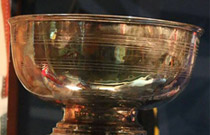
Original Goodall Cup, Hockey Hall of Fame, Toronto ON Canada, photograph by Jason Sangwin
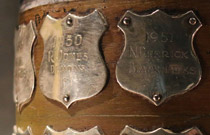
Victorian Ice Hockey League (VIHA) MVP Trophy, detail. Photograph by Jason Sangwin.
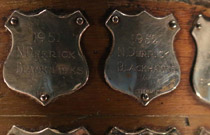
Victorian Ice Hockey League (VIHA) MVP Trophy, detail. Photograph by Jason Sangwin.
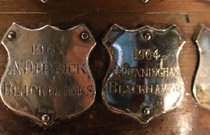
Victorian Ice Hockey League (VIHA) MVP Trophy, detail. Photograph by Jason Sangwin.
